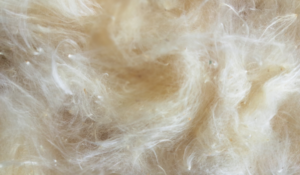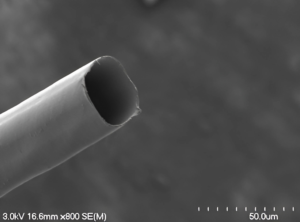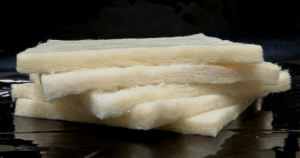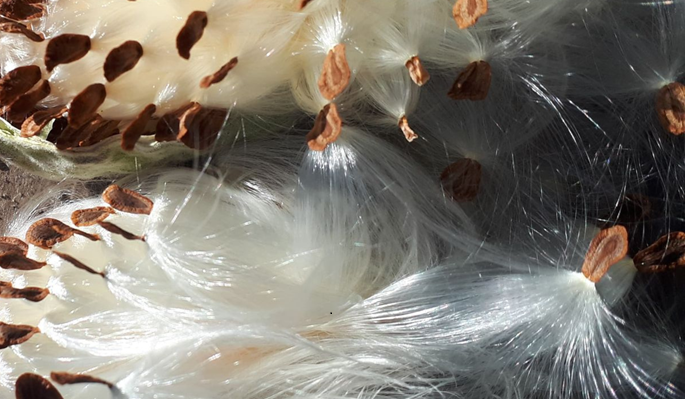Milkweed, why use it in a mixture ?
Milkweed fiber has exceptional qualities. A hollow structure that makes it ultra light, low density and so warm. Its hypoallergenic nature and its smooth wall that gives it its softness. When we observe a single fiber under a microscope, we see that it is composed of a very thin wall and a large lumen filled with air that give it excellent thermal and acoustic insulation capabilities. So why is it mixed with other materials ?


Like any natural fiber, milkweed fiber has certain morphological irregularities that result in poor mechanical properties. It is fragile and breaks easily. In order to overcome these two characteristics, it is therefore necessary to reinforce the milkweed fiber with a thermoplastic fiber with better mechanical properties and find a process that will prevent it from being damaged further.
A composition details the proportion of fibers based on their weight. Since milkweed fiber is much lighter than thermoplastic fibers (polyester, polypropylene, polylactic acid (PLA)), this means that by volume, there is little compared to milkweed fibers. Just enough to allow the plant fibers to bind well together and achieve the desired performance standards.
Technologies are constantly improving. With scientific research, we can hope that one day it will be possible to manufacture technical textiles from 100% plant fibers. In the meantime, we are working to reduce thermoplastic fibers as much as we can, without reducing the performance and durability of a product.
What about raw milkweed fiber ? Realistic ?
In addition, like any natural fiber, the use of milkweed fiber, even in its raw state, requires a preparation process before being integrated into the manufacture of a finished product to ensure good durability.
Once more, research is essential to ensure the stability of milkweed fiber as well as to highlight its thermal properties, throughout the life cycle of a product. By developing a winter mitten from a non-woven (quilted) fabric, we worked to prevent the fiber from sagging or moving, and the fingertips or thumb from finding themselves without insulation after some time of use.

Especially since in bulk, milkweed fiber also presents handling challenges in the factory, due to its volatility. This is also why Monark Cooperative must listen to the needs and production realities of manufacturers in order to allow them to consider a transition to a more plant-based material in their manufacturing processes.
In conclusion, like any natural fiber, milkweed fiber, even in its raw state, must be conditioned. Scientific research is therefore the key to perpetuating the milkweed fiber industry and ensuring that sustainable products made from milkweed fiber furnish our daily lives.

Marie-Noël Breton
Entrepreneure agricole, passionnée par la diversité florale et la pollinisation, Marie-Noël Breton a la fibre de l’innovation ! Membre de la coopérative depuis 2017 et aujourd'hui chargée de projet, elle a pour objectifs de promouvoir cette fibre locale aux propriétés exceptionnelles et rassembler les industries québécoises dans ce projet unique au monde !



